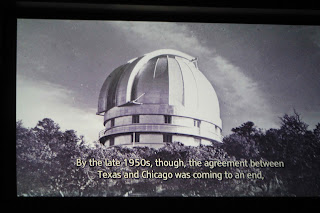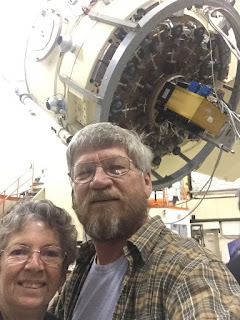Much to our relief, the weather is beautiful and just perfect for our tour at McDonald Observatory today.
We dillydallied a bit after arising. Cleaned up the Lil’ Home a bit. Edith tried to catch up on our travel blog, edited pictures.
It was 9:45 am when we got ready to go to McDonald Observatory, but stopped at the ranch office first to pay the campsite fee for tonight. We decided to stay here one more night, so there won’t be too much hassle after coming back from the tour. As we were leaving there were horse riders going to the mountains.
It took us 25 minutes from the ranch to the visitor’s parking lot at The Frank N. Bash Visitor Center area. We picked up the green stickers (Solar Viewing Program and Guided Tour) to identify that we paid for the tour. We went inside the theatre, watched the slide show (open captioned). Joe, our tour guide, explained about the galaxy, the sun and the universe, showed us the actual and live views of the Sun (not open captioned). We could see the sunspots and the flares. Joe explained that it takes 1.3 millions of Earth to fit inside the Sun!
 |
| Actual view of the sun You could see the sunspot |
 |
| The sunspots |
 |
| Sun Flares |
We picked up Shuttle Buss passes for us; otherwise, we would have to use the Jeep to follow the shuttle bus to two summits of Mt. Locke and Mt. Fowlkes. Riding the shuttle bus in the simplest and easiest way to go up on top of the mountains. We let Joe do the driving, so we can enjoy the scenery along the way.
First stop was to go to the top of Mt. Locke (6,791’ above sea level). We were led to the starting location where there is a scenic overlook on the south side. On a clear day like today the view from the overlook spans over a hundred miles in the distance. There are some landmarks visible from the spot. The 82” Otto Struve Telescope Dome, on the left from the 107” Dome, was the first telescope built at McDonald Observatory. It was funded by William J. McDonald, a wealthy banker from Paris, TX. After he passed away in 1926 he left almost a million dollars to the University of Texas and requested that the observatory be built with the money he left. The construction began in 1933 and was completed in 1939. At that time it cost $375,000 to build it (it would have cost $6 million dollars in today’s price).
 |
| 82" Otto Struve Telescope inside the dome |
Down below the 82’ is a 36” Reflector and it was the 2nd research telescope built. It was finished in 1956. The reason for having domes built on high altitude was for several reasons: Remoteness (far from city lights); Altitude (clearer view of the sky due to less of Earth’s atmosphere; Dryness (dry climate means more clear nights) and Latitude (close to the equator for more available targets).
 |
| 36" Reflector Dome on the bottom right side |
Also, the land that the domes are situated on was donated for FREE! Mrs. Violet Locke McIvor donated it and named it after her grandfather.
There are homes for the Director and Superintendent. Also, there is a long building for local and visiting astronomers.
Joe then led us to go inside the 107” Telescope Dome, briefly explained about the rules. There were two ways to get to the top inside the dome: 70 steps or an elevator. We chose to take the steps (we needed exercise).
We were in awe when we saw how BIG the telescope was. It was named after Harlan J. Smith, who served as Director of the Observatory from 1963-1989. Construction began in 1966 and was completed in 1968 at the cost of $7 million dollars (about $50 million in today’s dollars). After the completion it was the 3rd largest telescope in the world, but now is ranked #41.
 |
| Pano shot of the telescope |
 |
| Joe, our tour guide |
Joe demonstrated the motion of both the telescope and dome. It was fantastic to see how this massive thing moves without a glitch. The telescope weights 120 tons, is moved by a 1/3 horsepower motor!
Back to the shuttle bus and we went to Mt. Fowlkes where the Hobby-Eberly Telescope Dome is at. The telescope’s motion is limited to rotation, not altitude. The primary mirror has 91 segments, which weighs about 13 TONS! Each hexagonal segment is one meter across, about 2” thick.
After the end of the tour we were shuttled back to the visitor’s parking area, went inside the center and had lunch at Star Date Cafe. We drove the Jeep to Mt Locke and Mt Fowlkes, so Edith can get some more pictures at her leisure pace.
 |
| View of the Landscape from the Overlook at McDonald Observatory |
The tour lasted about 2 and half hours. Check the website for information on tours/prices. You may wonder if they provide interpreting services for the deaf guests. No, but they have transcripts that you can take with you and read as you go along with the guide.
We were planning on visiting Davis Mountains State Park afterwards, but Edith started to have an headache because of high pollen. Also, we were tired and needed a break from sightseeing.
More guests are checking into Prude Ranch, some of them staying in cabins. Two more RVs checked in. There was a group of horse riders going out of the corral.
We discussed on what routes to take after we check out of Fort Davis, TX tomorrow morning. We may go to Carlsbad, New Mexico. The elevator at Carlsbad Caverns is out of service and won't be restored until May. We think we are not going to visit the caverns until another time, but we will check Carlsbad town and look around. We might stay there for one night OR we may move on to another town.
















No comments:
Post a Comment